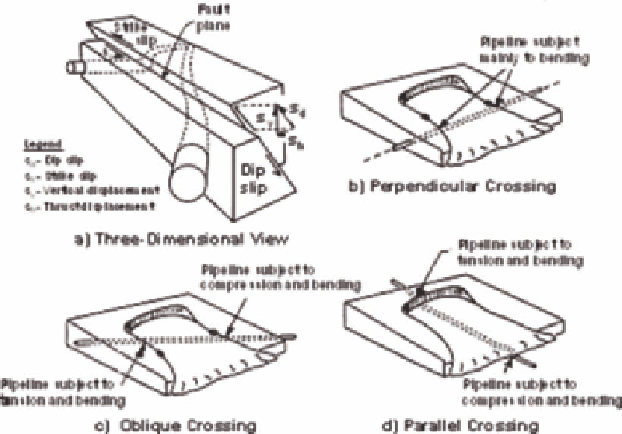Geoscience Reference
In-Depth Information
Fig. 17.2. Principal modes of soil-pipeline interaction triggered by earthquake-induced
PGD (O'Rourke, 1998)
to set upper bound estimates of deformation effects on buried lifelines by simplifying
spatially distributed PGDas movement concentrated along planes of soilfailure.
Various modes of pipeline distortion caused by PGD are illustrated in Figure 17.2.
Pipelines crossing a fault plane subjected to oblique slip are shown in Figure 17.2a.
Reverse and normal faults promote compression and tension, respectively. Strike slip
may induce compression or tension, depending on the angle of intersection between the
pipeline and fault. Figure 17.2b shows a pipeline crossing a lateral spread or landslide
perpendicular to the general direction of soil movement. In this orientation, the pipeline
is subject to bending strains and extension. As shown in Figure 17.2c, the pipeline will
undergo bending and either tension or compression at the margins of the slide when the
crossing occurs at an oblique angle. Figure 17.2d shows a pipeline oriented parallel to
the general direction of soil displacement. At the head of the zone of soil movement,
the displacements resemble normal faulting; under these conditions, the pipeline will be
subjected to both bending and tensile strains. At the toe of the slide, the displaced soil
produces compressive strainsin the pipeline.
Figure 17.3 shows a schematic of an underground pipeline deformed by mass move-
ment of soil associated with a landslide or lateral spread. Two zones are identified for
characterizing the soil-pipeline interaction. Near the center of the slide/lateral spread,
two-dimensional (2-D) conditions control lateral forces mobilized against the pipe by
relative horizontal displacement of the soil. Near the margins of the slide, where abrupt
displacement of the ground occurs, the interaction between pipeline and soil is more

